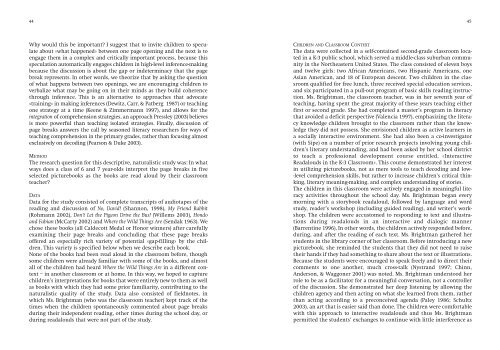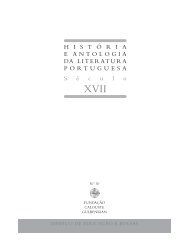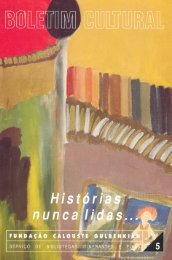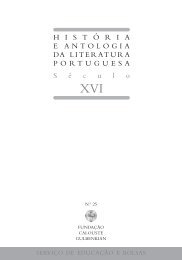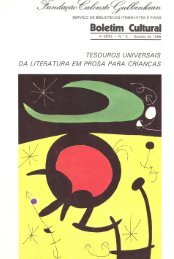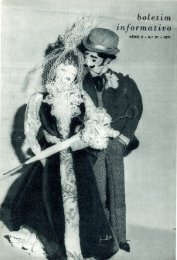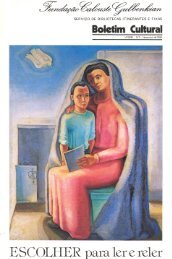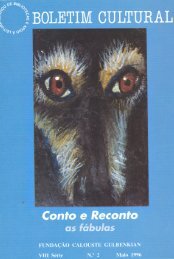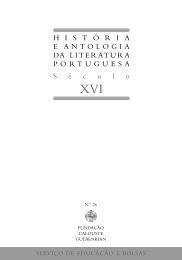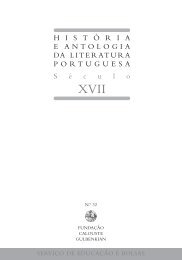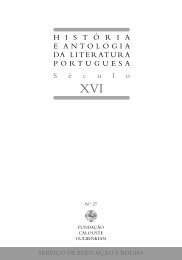Formar Leitores para Ler o Mundo - Leitura Gulbenkian - Fundação ...
Formar Leitores para Ler o Mundo - Leitura Gulbenkian - Fundação ...
Formar Leitores para Ler o Mundo - Leitura Gulbenkian - Fundação ...
You also want an ePaper? Increase the reach of your titles
YUMPU automatically turns print PDFs into web optimized ePapers that Google loves.
44<br />
Why would this be important? I suggest that to invite children to speculate<br />
about «what happened» between one page opening and the next is to<br />
engage them in a complex and critically important process, because this<br />
speculation automatically engages children in high-level inference-making<br />
because the discussion is about the gap or indeterminacy that the page<br />
break represents. In other words, we theorize that by asking the question<br />
of what happens between two openings, we are encouraging children to<br />
verbalize what may be going on in their minds as they build coherence<br />
through inference. This is an alternative to approaches that advocate<br />
«training» in making inferences (Dewitz, Carr, & Patberg 1987) or teaching<br />
one strategy at a time (Keene & Zimmermann 1997), and allows for the<br />
integration of comprehension strategies, an approach Pressley (2003) believes<br />
is more powerful than teaching isolated strategies. Finally, discussion of<br />
page breaks answers the call by seasoned literacy researchers for ways of<br />
teaching comprehension in the primary grades, rather than focusing almost<br />
exclusively on decoding (Pearson & Duke 2003).<br />
METHOD<br />
The research question for this descriptive, naturalistic study was: In what<br />
ways does a class of 6 and 7 year-olds interpret the page breaks in five<br />
selected picturebooks as the books are read aloud by their classroom<br />
teacher?<br />
DATA<br />
Data for the study consisted of complete transcripts of audiotapes of the<br />
reading and discussion of No, David! (Shannon, 1998), My Friend Rabbit<br />
(Rohmann 2002), Don’t Let the Pigeon Drive the Bus! (Willems 2003), Hondo<br />
and Fabian (McCarty 2002) and Where the Wild Things Are (Sendak 1963). We<br />
chose these books (all Caldecott Medal or Honor winners) after carefully<br />
examining their page breaks and concluding that these page breaks<br />
offered an especially rich variety of potential «gap-filling» by the children.<br />
This variety is specified below when we describe each book.<br />
None of the books had been read aloud in the classroom before, though<br />
some children were already familiar with some of the books, and almost<br />
all of the children had heard Where the Wild Things Are in a different context<br />
– in another classroom or at home. In this way, we hoped to capture<br />
children’s interpretations for books that were entirely new to them as well<br />
as books with which they had some prior familiarity, contributing to the<br />
naturalistic quality of the study. Data also consisted of fieldnotes, in<br />
which Ms. Brightman (who was the classroom teacher) kept track of the<br />
times when the children spontaneously commented about page breaks<br />
during their independent reading, other times during the school day, or<br />
during readalouds that were not part of the study.<br />
CHILDREN AND CLASSROOM CONTEXT<br />
The data were collected in a self-contained second-grade classroom located<br />
in a K-3 public school, which served a middle-class suburban community<br />
in the Northeastern United States. The class consisted of eleven boys<br />
and twelve girls: two African Americans, two Hispanic Americans, one<br />
Asian American, and 18 of European descent. Two children in the classroom<br />
qualified for free lunch, three received special education services,<br />
and six participated in a pull-out program of basic skills reading instruction.<br />
Ms. Brightman, the classroom teacher, was in her seventh year of<br />
teaching, having spent the great majority of these years teaching either<br />
first or second grade. She had completed a master’s program in literacy<br />
that avoided a deficit perspective (Valencia 1997), emphasizing the literacy<br />
knowledge children brought to the classroom rather than the knowledge<br />
they did not possess. She envisioned children as active learners in<br />
a socially interactive environment. She had also been a co-investigator<br />
(with Sipe) on a number of prior research projects involving young children’s<br />
literary understanding, and had been asked by her school district<br />
to teach a professional development course entitled, «Interactive<br />
Readalouds in the K-3 Classroom». This course demonstrated her interest<br />
in utilizing picturebooks, not as mere tools to teach decoding and low-<br />
-level comprehension skills, but rather to increase children’s critical thinking,<br />
literary meaning-making, and complex understanding of stories.<br />
The children in this classroom were actively engaged in meaningful literacy<br />
activities throughout the school day. Ms. Brightman began every<br />
morning with a storybook readaloud, followed by language and word<br />
study, reader’s workshop (including guided reading), and writer’s workshop.<br />
The children were accustomed to responding to text and illustrations<br />
during readalouds in an interactive and dialogic manner<br />
(Barrentine 1996). In other words, the children actively responded before,<br />
during, and after the reading of each text. Ms. Brightman gathered her<br />
students in the library corner of her classroom. Before introducing a new<br />
picturebook, she reminded the students that they did not need to raise<br />
their hands if they had something to share about the text or illustrations.<br />
Because the students were encouraged to speak freely and to direct their<br />
comments to one another, much cross-talk (Nystrand 1997; Chinn,<br />
Anderson, & Waggoner 2001) was noted. Ms. Brightman understood her<br />
role to be as a facilitator for a meaningful conversation, not a controller<br />
of the discussion. She demonstrated her deep listening by allowing the<br />
children agency and then acting on what she learned from them, rather<br />
than acting according to a preconceived agenda (Paley 1986; Schultz<br />
2003), an art that is easier said than done. The children were comfortable<br />
with this approach to interactive readalouds and thus Ms. Brightman<br />
permitted the students’ exchanges to continue with little interference as<br />
45


